Martin G. Brodwin, Aracely Rosales and R. David Black, California State University, Los Angeles
History and Background of Universal Design
Rehabilitation counselors and educators can serve students who have disabilities more effectively by understanding and applying the concepts of universal design (UD). Universal design is the name of a specific design approach that incorporates inclusive design features, while minimizing the need for individual accommodations. It can enhance access to higher education and employment for people with disabilities and those with chronic medical conditions.
In the 1960s, Ronald Mace (1985), an architect and wheelchair user, stated that physical environments should be designed to meet the needs of the “broadly diverse individuals who access these areas.” While the principles of UD were originally intended for architecture, they were later applied to product and environmental design. “Everyone benefits from UD because it takes into account the full range of human diversity, including physical, cognitive, and perceptual differences, as well as differences in body shapes and sizes” (Young, Stiens, O’Young, Baldwin, & Thatcher, 2017, pp. 700-701).
Universal Design Defined
UD incorporates various technologies, both assistive and mainstream. In education, computer-based testing with read aloud capability has demonstrated effectiveness for students with learning disabilities to increase test question comprehension and improve test scores. Educators who have included universal design have also used it to improve reading comprehension in students with intellectual disabilities. In employment, technologies used to enhance functioning include audio prompting devices, video-assisted training, computers, and augmentative and alternate communication for people with developmental disabilities.
Application of Universal Design
There are many positive aspects to implementing UD. Often, applying the principles of universal design and supporting the student or employee with a disability or chronic illness is accomplished through assistive technology, accommodations, changing job requirements, or modifying the work environment or classroom instruction. Additionally, these approaches benefit other students or employees without disabilities. The application of ergonomic practices is a strategy of universal design as this benefits other employees by improving the work environment and reducing work-related accidents and injuries.
Although the concepts of UD have been around for over five decades in architecture and product design, it is relatively recent in education and the workplace. Many in the fields of education and business are not accustomed to designing curricula or workplace environments to meet the needs of all individuals (Black, Weinberg, & Brodwin, 2015). Currently, modifications are placed after an individual with a disability requests an accommodation rather than during the design process. This mindset or lack of familiarity with UD serves as a barrier to implementation. Counselors can educate and assist schools and employers in strategies to accommodate, assist, and include individuals with disabilities by using the principles of universal design.
Role of the Rehabilitation Professional
In applying the principles of UD, the rehabilitation professional must take into account the functional needs of the individual and ensure that accommodations match those needs. This includes use of assistive or adaptive technology, devices, equipment, and changes in work tasks. An example is the use of a closed circuit television (CCTV) to magnify hard copy material during exams for a student with low vision. In many instances, the CCTV is slow as it takes time for the individual to magnify each section of the text, causing fatigue. Extended use may cause eyestrain, and may not improve understanding of the text. In some situations, use of a CCTV may be more appropriate for use during shorter durations when materials have not been converted to electronic format.
Additionally, rehabilitation professionals must also remember that usability of equipment, technologies and software is just as significant as accessibility. It is important to keep this in mind to limit additional barriers or constraints for individuals with disabilities. Rehabilitation professionals are valuable resources to schools and employers to provide education and evaluation for accommodations and inclusion. They are also an invaluable resource in promoting UD principles to make school curricula and work environments accessible and usable for persons of all abilities. Using the concepts of universal design, counselors and educators can assist students with disabilities within the learning environment.
References
Black, R. D., Weinberg, L. A., & Brodwin, M. G. (2015). Universal design for learning and instruction: Perspectives of students with disabilities in higher education. Exceptionality Education International, 25, 1-16.
Mace, R. L. (1985). Universal design: Barrier free environments for everyone. Designers West, 33(1), 147–152.
Young, M., Stiens, S. A., O’Young, B., Baldwin, R., & Thatcher, B. N. (2017). Assistive technology: Adaptive tools for enablement for multiple disabiliites. In A. Moroz, S. R. Flanagan, and H. H. Zaretsky (Eds.), Medical aspects of disability for the rehabilitation professional (5th ed., pp. 697-711). New York, NY: Springer.
